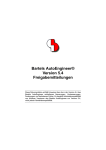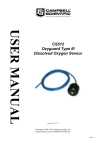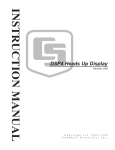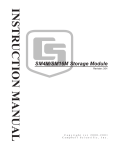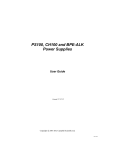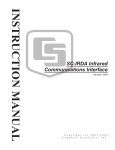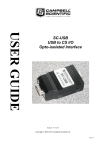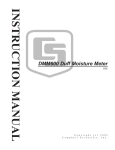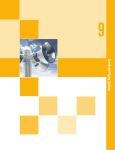Download Campbell SC932A Instruction manual
Transcript
INSTRUCTION MANUAL SC932 9-Pin to RS-232-DCE Interface Revision: 4/03 C o p y r i g h t ( c ) 1 9 8 7 - 2 0 0 3 C a m p b e l l S c i e n t i f i c , I n c . Warranty and Assistance The SC932 9 PIN TO RS-232-DCE INTERFACE is warranted by CAMPBELL SCIENTIFIC, INC. to be free from defects in materials and workmanship under normal use and service for twelve (12) months from date of shipment unless specified otherwise. Batteries have no warranty. CAMPBELL SCIENTIFIC, INC.'s obligation under this warranty is limited to repairing or replacing (at CAMPBELL SCIENTIFIC, INC.'s option) defective products. The customer shall assume all costs of removing, reinstalling, and shipping defective products to CAMPBELL SCIENTIFIC, INC. CAMPBELL SCIENTIFIC, INC. will return such products by surface carrier prepaid. This warranty shall not apply to any CAMPBELL SCIENTIFIC, INC. products which have been subjected to modification, misuse, neglect, accidents of nature, or shipping damage. This warranty is in lieu of all other warranties, expressed or implied, including warranties of merchantability or fitness for a particular purpose. CAMPBELL SCIENTIFIC, INC. is not liable for special, indirect, incidental, or consequential damages. Products may not be returned without prior authorization. The following contact information is for US and International customers residing in countries served by Campbell Scientific, Inc. directly. Affiliate companies handle repairs for customers within their territories. Please visit www.campbellsci.com to determine which Campbell Scientific company serves your country. To obtain a Returned Materials Authorization (RMA), contact CAMPBELL SCIENTIFIC, INC., phone (435) 753-2342. After an applications engineer determines the nature of the problem, an RMA number will be issued. Please write this number clearly on the outside of the shipping container. CAMPBELL SCIENTIFIC's shipping address is: CAMPBELL SCIENTIFIC, INC. RMA#_____ 815 West 1800 North Logan, Utah 84321-1784 CAMPBELL SCIENTIFIC, INC. does not accept collect calls. SC932 Table of Contents PDF viewers note: These page numbers refer to the printed version of this document. Use the Adobe Acrobat® bookmarks tab for links to specific sections. 1. General Description....................................................1 2. Specifications .............................................................2 3. Installation...................................................................3 3.1 3.2 3.3 3.4 Two Way Communication ........................................................................3 One Way Communication.........................................................................4 Two Way or One Way Communication....................................................4 Jumper Descriptions..................................................................................6 4. RAD Modem Application ............................................7 4.1 4.2 4.3 4.4 4.5 RAD Modem - Two Way..........................................................................7 RAD Modem - One Way ..........................................................................8 RAD Modem - Two Way or One Way .....................................................9 RAD Modem Wiring and Grounding........................................................9 Testing RAD Modem Communication ...................................................11 1. 2. 3. 4. 5. 6. 7. SC932 9-Pin to RS-232-DCE Interface ......................................................1 SC932 Jumper Locations ............................................................................5 SC932 Jumper Descriptions........................................................................5 Two Way Communication ..........................................................................7 One Way Communication...........................................................................8 Two Way or One Way Communication......................................................9 Installation of Spark Gap Protection.........................................................10 Figures Table 1. Approximate Range, miles and km .............................................................7 i This is a blank page. SC932 9-Pin to RS-232-DCE Interface FIGURE 1. SC932 9-Pin to RS-232-DCE Interface 1. General Description The SC932 (Figure 1) is used to interface a CSI datalogger to any modem that is configured with an RS-232 DCE (Data Communications Equipment) serial port. Features include: • True RS-232 signal levels. • Power for the SC932 is supplied from the 5 V supply on pin 1 of the datalogger’s I/O port. The SC932 will use the 5 V supply to power the RS-232 modem if needed. • Power usage is jumper configurable for certain hardware configurations. • Jumper selectable for two way (interactive) communication, one way (output or printer) communication, or both. The SC932 is most frequently used with a short haul modem to communicate across a dedicated line made of 2 pairs of twisted wire with a shield. Section 3 describes the details of this application using a short haul modem built by RAD. The SC932 is also commonly used with the satellite transmitters and spread spectrum radios. 1 SC932 9-Pin to RS-232-DCE Interface 2. Specifications 25 Pin Male Connector Pin-out: Pin No. I/O 1 2 3 4 7 20 22 out in out out in Name Description GND TXD RXD RTS GND DTR RING Chassis Ground SC932 transmits data on this line SC932 receives data on this line Held active by SC932 (see jumper description Signal Ground Held active by SC932 (see jumper description Rings datalogger 9 Pin Male Connector Pin-out: Pin No. I/O Name Description 1 2 3 4 5 6 9 +5V GND RING RXD ME SDE TXD Regulated 5 Volt supply Ground Ring signal to datalogger SC932 transmits on this line Modem Enable Synchronous Device Enable SC932 receives on this line in out out in in in Data Rates The SC932 will support baud rates up to 19,200 bps 2 SC932 9-Pin to RS-232-DCE Interface Electrical The SC932 uses power from the +5 V line on the 9 pin interface connected to the datalogger. The SC932 uses only a few microamps while inactive and about 5 mA when active from the 5 V supply. Additional current (up to 10 mA) from the 5 V supply may be used by the RS-232 device connected to the SC932. Physical Height: Width: Length: Weight: Mounting: 1.0 in (25 mm) 3.5 in (90 mm) 4.1 in (103 mm) 4.3 oz (123 g) 3 in by 3 in centered holes Environmental Temperature: -25 to +50oC Humidity: up to 95% non-condensing 3. Installation Proper transient protection should be installed to protect the computer and datalogger in areas where damage due to lightning is possible. If this is a RAD modem application, see Section 4. 3.1 Two Way Communication: 1. Remove the SC932 lid by removing the screw from the top of the box. 2. Jumper P3 between pins 1-2 (activated by Modem Enable) to set the SC932 for two way communication. See Figures 2 and 3. 3. Select the jumper configuration of P2 and P4 that will minimize power requirements and yet still allow the SC932 to function. There are three valid configurations of these jumpers. Having both P2 and P4 open will require the least power. Jumpering P4 only is the middle power level. Jumpering P2 only requires the most power. Modem devices which draw power from the SC932 interface usually require one of the higher power levels. If the RAD modem is being used, Section 4 describes the jumper settings to use. 4. Replace the lid. 5. Connect the SC932 to the RS-232 device and to the datalogger with the SC12 9 pin cable (included). 3 SC932 9-Pin to RS-232-DCE Interface 3.2 One Way Communication 1. Remove the SC932 lid by removing the screw from the top of the box. 2. Jumper P3 between pins 3-4 to set the SC932 to one way data only. The SC932 is activated by pin 6 synchronous device enable (SDE) on the datalogger’s serial I/O port. See Figures 2 and 3. 3. Select the jumper configuration of P2 and P4 that will minimize power requirements and yet still allow the SC932 to function. There are three valid configurations of these jumpers. Having both P2 and P4 open will require the least power. Jumpering P4 only is the middle power level. Jumpering P2 only requires the most power. Modem devices which draw power from the SC932 interface usually require one of the higher power levels. If the RAD modem is being used, Section 4 describes the jumper settings to use. 4. Replace the lid. 5. Connect the SC932 to the RS-232 device and to the datalogger with the SC12 9 pin cable (included). 3.3 Two Way or One Way Communication 4 1. Remove the SC932 lid by removing the screw from the top of the box. 2. Jumper P3 between pins 1-2 and between pins 3-4 to set the SC932 for two way or one way telecommunications. See Figures 2 and 3. 3. Select the jumper configuration of P2 and P4 that will minimize power requirements and yet still allow the SC932 to function. There are three valid configurations of these jumpers. Having both P2 and P4 open will require the least power. Jumpering P4 only is the middle power level. Jumpering P2 only requires the most power. Modem devices which draw power from the SC932 interface usually require one of the higher power levels. If the RAD modem is being used, Section 4 describes the jumper settings to use. 4. Replace the lid. 5. Connect the SC932 to the RS-232 device and to the datalogger with the SC12 9 pin cable (included). SC932 9-Pin to RS-232-DCE Interface P2 P3 P4 FIGURE 2. SC932 Jumper Locations FIGURE 3. SC932 Jumper Descriptions 5 SC932 9-Pin to RS-232-DCE Interface 3.4 Jumper Descriptions The following guidelines are used to determine the proper jumper configuration for the modem being used. When selecting a jumper configuration always try to keep current drain to a minimum. Current Drain LO MEDIUM HIGH 6 Jumper Position Description P3 1-2 Allows SC932 to act as a Datalogger Modem device (two way communication). SC932 is activated by modem enable (ME) line. 3-4 Allows SC932 to act as a Datalogger Printer device (one way). SC932 is activated by pin 6 synchronous device enable (SDE) on the datalogger’s Serial I/O port. 1-2 3-4 Allows SC932 to act as both of the above. The one way data mode resumes once the modem enable (ME) is dropped. The ME line is dropped when the two way communication is shut down or after 40 seconds of inactivity. P2 Open P4 Open P2 Open P4 Installed P2 Installed P4 Open DTR and RTS are held at 9V while the SC932 is active. They are not driven while the SC932 is not active. This jumper selection should be used when the SC932 is being used for Printer data or when the RS-232 device connected to the SC932 can produce a ring or RXD signal while DTR, RTS, and TXD are not powered (e.g. Hayes Modem). DTR and RTS are held at 4.3V while the SC932 is not active and 9V while active. This jumper selection should be used when the RS-232 device connected to the SC932 can produce a ring or RXD signal when DTR and RTS are at 4.3V and TXD is not driven. This configuration will take more power than when both P2 and P4 are open depending on the RS-232 device (e.g. RAD modems). DTR and RTS are held at 9V all the time. This configuration takes the most power, and provides fully active RS-232 signals on the DTR, RTS, and TXD lines all the time. Any RS-232 compatible device should work with this jumper selection. SC932 9-Pin to RS-232-DCE Interface 4. RAD Modem Application The SC932 is most frequently used with a short range modem to communicate across a 4-wire, unconditioned dedicated line. This section describes the details of this application using a short range asynchronous modem built by RAD*. * SRM - 5A RAD Modem RAD Data Communications Inc. 900 Corporate Drive Mahwah, NJ 07430 Tel: (201) 529-1100 Fax: (201) 529-5777 Email: [email protected] http://www.rad.com For transmission, the RAD modem uses a cable made of 2 pairs of twisted wires with a shield. Data rates up to 9600 bps are possible. The low voltage transmission levels minimize cross-talk between adjacent lines within the same cable. Data are transmitted and received at a balanced impedance, providing excellent immunity to circuit noise. Table 1 gives the data rate possible for several gage cables across several distances. TABLE 1. Approximate Range, miles and km Data Rate bps 19 Gauge (0.9 mm) miles km 24 Gauge (0.5 mm) miles km 26 Gauge (0.4 mm) miles km 9,600 1,200 6.2 7.6 2.8 3.4 2.0 2.5 10.0 12.2 4.5 5.5 3.3 4.0 Figures 4, 5, and 6 show specific jumper settings for three applications with the RAD Modem. Figure 4 is an example of two way communication with a computer, Figure 5 shows one way communication to a printer or display, and Figure 6 shows both. Note the differences in jumper settings. 4.1 RAD Modem - Two Way FIGURE 4. Two Way Communication 7 SC932 9-Pin to RS-232-DCE Interface The SC932 leaves the factory with the jumpers set as shown in Figure 4. In this mode, the SC932 and RAD modem combined will require about 2 mA while inactive and less than 20 mA while active. When using Campbell Scientific’s PC208W telecommunications software to communicate through the SC932/RAD modem, “Setup” the link as a direct connect between the datalogger and the desired COM port. Start two way communication using the “Connect” button on the Tool bar and the “Connect” button in the “Connect” window. 4.2 RAD Modem - One Way FIGURE 5. One Way Communication In this mode, the SC932 and RAD modem combined will require about 2 mA while inactive and less than 20 mA while active. Use Instruction 96 in the datalogger to output data to a printer or display. The bit rate, parity, start and stop bits must be the same in the datalogger and the display/printer. The datalogger sends the data as 8 data bits, no parity, 1 start bit and 1 stop bit. When using Campbell Scientific’s PC208W telecommunications software to display “printer” data sent by the datalogger “Setup” the link as a direct connect between the datalogger and the desired COM port. Start one way communication using the “Connect” button on the Tool bar, the “Terminal” tab, and the “Open Port” button in the “Terminal” tab. Wait for the data to be displayed. NOTE 8 Only one twisted pair is required for one way communication. Refer to RAD manual for wire connections. SC932 9-Pin to RS-232-DCE Interface 4.3 RAD Modem - Two Way or One Way FIGURE 6. Two Way or One Way Communication In the jumper configuration shown in Figure 6, the communication mode, two way or one way is determined by the modem enable line. Communication is two way if the modem enable line is high, one way if modem enable is low. In this mode, the SC932 and RAD modem combined will require about 2 mA while inactive and less than 20 mA while active. Two way setup and connect: same as two way only. One way setup and connect: same as one way only. 4.4 RAD Modem Wiring and Grounding Figure 7 shows a typical setup of the RAD modems. Installation is as follows: 1. Set the DCE/DTE switch on the back of the RAD modem connected to the SC932 to DCE. For a RAD modem connected to a PC, set the DCE/DTE switch to DCE. For a RAD modem connected to a serial printer, set the DCE/DTE switch to DTE. 2. Select a cable with two or more twisted pairs. A recommended direct burial rodent resistant cable is listed below. They also sell several gopher resistant cables for even greater protection. Company Part Number Anixter F-02P22BPN Tel: 847-677-2600 http://www.anixter.com AWG. 22 3. Wiring connections are made as shown in Figure 7. Note wires labeled A and B are one twisted pair of the cable. Wires labeled C and D are the other twisted pair. 4. Transients induced on the communication line may damage any electronics connected at either end of the line. To decrease the chances for damage, spark gaps should be installed as shown in Figure 7. The 9 SC932 9-Pin to RS-232-DCE Interface transient protection shown may be purchased from Campbell Scientific, Inc. (p.n. 5563 shown in Figure 7, p.n. 6536 includes a plastic case, p.n. 6361 includes hardware for mounting to ground lug of CSI enclosures models ENC 10/12, ENC 12/14, or ENC 16/18). Spark gap wiring is straight through such that pin to pin continuity exists between the two modems. If the modems are installed entirely within a building, the transient spark gap protection is probably not needed. FIGURE 7. Installation of Spark Gap Protection 10 SC932 9-Pin to RS-232-DCE Interface Occasionally a customer needs to transmit data across longer or smaller gage wires or at higher speeds than can be done with the RAD modem powered by the SC932. RAD does sell a 9 volt power supply that will boost the signals enough to meet some of these more demanding applications. Please contact RAD for more information. 4.5 Testing RAD Modem Communication The modem communication link is divided into the following three sections: 1) RAD modem computer end, 2) cable from computer modem to datalogger modem, 3) RAD modem datalogger end. When unable to establish communication with the datalogger, test each of the three sections. Before proceeding through the testing procedures, a terminal emulator software program such as “KERMIT”, “PROCOMM”, or Campbell Scientific’s PC208W (Remote Keyboard Display Terminal) must be used to communicate through the COM port of the computer. Once the emulator program is set up, testing can proceed as follows: 1. Disconnect the 4 conductor cables from the SRM-6A RAD modem at the computer end. Jumper the XMT + to RCV + and jumper the XMT - to RCV -. This creates a transmit loop which allows any key pressed at the computer keyboard to be seen on the screen. If the key pressed is not seen, check the following: COM port configuration, 25 pin cable from the computer to the modem and the RAD modem. 2. Reconnect the 4 conductor cables to the modem at the computer end and disconnect the cable from the modem at the datalogger end. Twist together the XMT + wire and RCV + wire, twist together the XMT - wire and the RCV - wire. Repeat the process of step 1 by pressing a key on the computer keyboard. If the key pressed is not returned, then the cable from the modem at the computer to the datalogger modem is defective and will need to be repaired or replaced. 3. If steps 1 and 2 pass, the modem at the datalogger is suspect. Disconnect the modem from the SC932 and bring the modem to the computer site. Attach the modem to the computer, and repeat step 1 by jumpering the terminals of the modem and pressing a key on the computer keyboard. If the above tests pass and communication to the datalogger still has not been established, perform tests 4, 5, and 6. 4. A 12 V lead acid battery supply should not be discharged below 11.76 V. If this occurs, the batteries will go into a deep discharge state and will need to be replaced. The CR10 will function properly on a battery voltage of 10 to 15 volts. Check the 12 V supply with a volt meter. 5. On the wiring panel of most Campbell Scientific dataloggers there is a terminal marked 5 V. Check the 5 V supply with a volt meter. This 5 V supply should be within a tenth of a volt. If not, it would indicate a problem. 11 SC932 9-Pin to RS-232-DCE Interface 6. To verify that the datalogger and its serial I/O port are working, try to access input memory locations using a laptop PC with the SC32B or the CR10KD Keyboard Display. If the datalogger passes tests 4, 5, and 6, then the SC932 is suspect and will need to be repaired or replaced. 12 This is a blank page. Campbell Scientific Companies Campbell Scientific, Inc. (CSI) 815 West 1800 North Logan, Utah 84321 UNITED STATES www.campbellsci.com [email protected] Campbell Scientific Africa Pty. Ltd. (CSAf) PO Box 2450 Somerset West 7129 SOUTH AFRICA www.csafrica.co.za [email protected] Campbell Scientific Australia Pty. Ltd. (CSA) PO Box 444 Thuringowa Central QLD 4812 AUSTRALIA www.campbellsci.com.au [email protected] Campbell Scientific do Brazil Ltda. (CSB) Rua Luisa Crapsi Orsi, 15 Butantã CEP: 005543-000 São Paulo SP BRAZIL www.campbellsci.com.br [email protected] Campbell Scientific Canada Corp. (CSC) 11564 - 149th Street NW Edmonton, Alberta T5M 1W7 CANADA www.campbellsci.ca [email protected] Campbell Scientific Ltd. (CSL) Campbell Park 80 Hathern Road Shepshed, Loughborough LE12 9GX UNITED KINGDOM www.campbellsci.co.uk [email protected] Campbell Scientific Ltd. (France) Miniparc du Verger - Bat. H 1, rue de Terre Neuve - Les Ulis 91967 COURTABOEUF CEDEX FRANCE www.campbellsci.fr [email protected] Campbell Scientific Spain, S. L. Psg. Font 14, local 8 08013 Barcelona SPAIN www.campbellsci.es [email protected] Please visit www.campbellsci.com to obtain contact information for your local US or International representative.



















